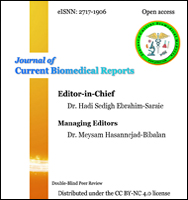Effects of laparoscopic sleeve gastrectomy on serum lncRNA levels in obese patients
Abstract
Obesity is a disease associated with excessive fat accumulation in the body, which body mass index (BMI) is greater than 30 kg/m. Bariatric surgery technique is one of the most common treatment options for obesity with the advantage of faster weight loss in a short time. lncRNAs play a role in adipogenesis and metabolic diseases, including obesity, type 2 diabetes, cardiovascular disease (CVD), osteoarthritis, and hypertension, so they are significant targets for therapeutic options. In this study, we aimed to determine lncRNAs and specific parameters that show different expressions in the plasma of patients with obesity. We included fifteen patients with BMI greater than 30 kg/m2 before and less than 30 kg/m2 after laparoscopic sleeve gastrectomy (LSG) in the study. Total RNAs, including lncRNAs and other non-coding RNAs, were isolated from plasma samples of patients, and eight lncRNAs (H19, Neat1, HOTAIR, ANRIL, MALAT1, ATB, SNGH5, UCA1) were quantified by real-time PCR. Gene Ontology, KEGG, and relation of obesity analysis were utilized. Unpaired Student's t-test Pearson correlation analysis was used for statistical analysis. We observed a statistically significant increase in the expression levels of all lncRNAs in the patients with the post-operative BMI change. We have added a new dimension to the biomarker studies related to obesity and the clinical follow-up of patients undergoing LSG surgery. Further studies are required for enlighting the molecular mechanisms.
Keywords
References
Blüher M. Obesity: global epidemiology and pathogenesis. Nat Rev Endocrinol. 2019; 15(5):288-98.
Whitlock G, Lewington S, Sherliker P, Clarke R, Emberson J, Halsey J, et al. Body-mass index and cause-specific mortality in 900 000 adults: collaborative analyses of 57 prospective studies. Lancet. 2009; 373(9669):1083-96.
Nguyen NT, Varela JE. Bariatric surgery for obesity and metabolic disorders: state of the art. Nat Rev Gastroenterol Hepatol. 2017; 14(3):160-69.
Nimptsch K, Konigorski S, Pischon T. Diagnosis of obesity and use of obesity biomarkers in science and clinical medicine. Metabolism. 2019; 92:61-70.
Daneshmoghadam J, Omidifar A, Akbari DN, Karimi Z, Emamgholipour S, Shanaki M. The gene expression of long non-coding RNAs (lncRNAs): MEG3 and H19 in adipose tissues from obese women and its association with insulin resistance and obesity indices. J Clin Lab Anal. 2021; 35(5):e23741.
Yao D, Lin Z, Zhan X, Zhan X. Identifying potential functional lncRNAs in metabolic syndrome by constructing a lncRNA-miRNA-mRNA network. J Hum Genet. 2020; 65(11):927-38.
Rey F, Zuccotti GV, Carelli S. Long non-coding RNAs in metabolic diseases: from bench to bedside. Trends Endocrinol Metab. 2021; 32(10):747-49.
Van der Klaauw AA, Farooqi IS. The hunger genes: pathways to obesity. Cell. 2015; 161(1):119-32.
Zhao XY, Lin JD. Long Non-coding RNAs: A New Regulatory Code in Metabolic Control. Trends Biochem Sci. 2015; 40(10):586-96.
Wijesinghe SN, Nicholson T, Tsintzas K, Jones SW. Involvements of long non-coding RNAs in obesity-associated inflammatory diseases. Obes Rev. 2021; 22(4):e13156.
Tokgun O, Tokgun PE, Inci K, Akca H. lncRNAs as Potential Targets in Small Cell Lung Cancer: MYC -dependent Regulation. Anticancer Agents Med Chem. 2020; 20(17):2074-81.
Huang da W, Sherman BT, Lempicki RA. Bioinformatics enrichment tools: paths toward the comprehensive functional analysis of large gene lists. Nucleic Acids Res. 2009; 37(1):1-13.
Yang L, Li P, Yang W, Ruan X, Kiesewetter K, Zhu J, et al. Integrative Transcriptome Analyses of Metabolic Responses in Mice Define Pivotal LncRNA Metabolic Regulators. Cell Metab. 2016; 24(4):627-39.
Sun J, Ruan Y, Wang M, Chen R, Yu N, Sun L, et al. Differentially expressed circulating LncRNAs and mRNA identified by microarray analysis in obese patients. Sci Rep. 2016; 6:35421.
Huang Y, Zheng Y, Jin C, Li X, Jia L, Li W. Long Non-coding RNA H19 Inhibits Adipocyte Differentiation of Bone Marrow Mesenchymal Stem Cells through Epigenetic Modulation of Histone Deacetylases. Sci Rep. 2016; 6:28897.
Cooper DR, Carter G, Li P, Patel R, Watson JE, Patel NA. Long Non-Coding RNA NEAT1 Associates with SRp40 to Temporally Regulate PPARγ2 Splicing during Adipogenesis in 3T3-L1 cells. Genes (Basel). 2014 5(4):1050-63.
Divoux A, Karastergiou K, Xie H, Guo W, Perera RJ, Fried SK, et al. Identification of a novel lncRNA in gluteal adipose tissue and evidence for its positive effect on preadipocyte differentiation. Obesity (Silver Spring). 2014; 22(8):1781-5.
Han J, Shen L, Zhan Z, Liu Y, Zhang C, Guo R, et al. The long non-coding RNA MALAT1 modulates adipose loss in cancer-associated cachexia by suppressing adipogenesis through PPAR-γ. Nutr Metab (Lond). 2021; 10;18(1):27.
Malek M, Yousefi R, Safari S, Seyyedi SHS, Mottaghi A. Dietary Intakes and Biochemical Parameters of Morbidly Obese Patients Prior to Bariatric Surgery. Obes Surg. 2019; 29(6):1816-22.
SantaCruz-Calvo S, Bharath L, Pugh G, SantaCruz-Calvo L, Lenin RR, et al. Adaptive immune cells shape obesity-associated type 2 diabetes mellitus and less prominent comorbidities. Nat Rev Endocrinol. 2022; 18(1):23-42.
Goodarzi MO. Genetics of obesity: what genetic association studies have taught us about the biology of obesity and its complications. Lancet Diabetes Endocrinol.2018; 6(3):223-36.
DOI: https://doi.org/10.52547/jcbior.3.1.20
Refbacks
- There are currently no refbacks.
Copyright (c) 2022 © The Author(s)

This work is licensed under a Creative Commons Attribution-NonCommercial 4.0 International License.













